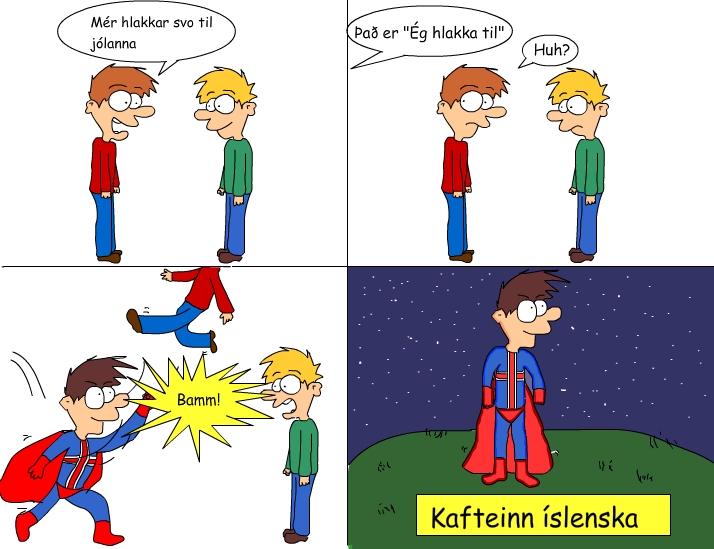The Magic of Neologisms in Icelandic Posted by Meg on Apr 30, 2017 in Icelandic grammar
One of my favorite parts of learning and speaking Icelandic is creating my own words. It feels empowering, like I’ve autonomously used this incredibly complex language I’ve set myself the task of learning. “Neologisms” are newly created words/expressions (sometimes, a new usage of an existent word/expression). And spinning them is my daytime substitute for dreaming in Icelandic , if you will, because, to me, it’s a symbol that I’m really getting the hang of it, that I’m absorbing how certain words are used in an everyday context.
My ‘creations’ tend to – as you might imagine – align with my disciplines: ljóðmóðir (a play on ljósmóðir, a midwife; the neologism meaning ‘one who delivers poems’). Then there’s þýðska (‘translation-ese’: þýða + the suffix “-sk” + the nominative declension ending “a”). Skítlenska (or, as my Icelandic-speaking compatriot suggested, skrítlenska – meaning those days when you just can’t speak Icelandic quite right. In the former case, when you speak so poorly you should get a medal. Another greatest-hit: one of my professors in design here at the University suggested “tjákn” [a combination of að tjá – to express and tákn – a symbol] to mean “emoji”.
Those aren’t exactly exemplars of the types of words that actually enter into the language and become commonly used. Tjámerki is the dictionary-official Icelandic term for emoji, though I’ve only heard ’emoji’.
Examples in English of neologisms in the realm of general speech are “to google/to facebook/to Instagram/to twerk.” Of course, when you get right down to it, all words are neologism, since all words were once new. I’ve read arguments in my discipline (poetics) that all words are also cliché because they’ve all been overused to the point of losing their original effect and neologism has the ability to sort of renew language.
In the case of my own neologisms, they’re what one might call “augnablikssamsetningar” (ABS) – or in-the-moment-compounds. These are commonplace in Icelandic, and they won’t really appear in the dictionary; examples of ABS that aren’t of my own making are “tepokatöng,” and “vindsængurpoki” – tea bag tongs and air-mattress bag. In my next blog, I’m going to explore compounds words in more detail so that you can make your own!
So “nýyrði” (neologism/s) are the kin of ABS; I’m talking about words that have been recorded in the dictionary, entered common parlance successfully, or failed/quasi-failed to be adopted in everyday language.
Advancements in technology (+changes in social media, etc.) tend to lead to the creation of neologisms. In Icelandic, there tends to be a lot of discussion about whether the term should be a borrow-word (tökuorð) and remain relatively intact, or if an Icelandic word should be created for the device.
According to Vísindavefurinn at the University of Iceland, there was a big discussion about the word app in 2011-2012, with the rise in popularity of smart phones. The Arni Magnusson Institute for Icelandic Studies collected at least 50 Icelandic neologisms that could be used instead of “app” – but none of them took. Apparently (couldn’t resist), app aligns with the Icelandic declension system, and is categorized as a neuter noun.
And, of course, neologisms reflect sociopolitical changes. Aflandskrónur (off-shore Icelandic krona, offshore accounts) came about in the last few months, reflecting the offshore accounts of Icelandic politicians involved in the Panama Papers.
There’s even a neologism competition in Iceland (held intermittently?) – and the latest winner was the word útréttur: take-out (literally out-food). There’s a whole list of the finalists for the prize – see if you can figure out what each word (e.g., hremma, gripill) means and post your ideas in the comments!
And, to wrap up this blog, I want to point out that a lot of Icelandic neologisms are direct translations of foreign words – a few examples are deilihagkerfi (e. sharing economy), hatursglæpur (e. hate crime) and hefndarklám (e. revenge porn). The term for this type of neologism is “tökuþýðingar” – itself a neologism built from “tökuorð,” borrow word, and þýðing, translation.
And just for fun, I give you, Captain Icelandic:

Build vocabulary, practice pronunciation, and more with Transparent Language Online. Available anytime, anywhere, on any device.






Comments:
THE Polyglot Wannabe:
Icelandic has a good capacity to create brand new neologisms; I like “tjámerki” more than “emoji” because it sounds like a genuinely cool word…
And skítlenska is the perfect word to describe my Icelandic
Sæll! This is a nice post.